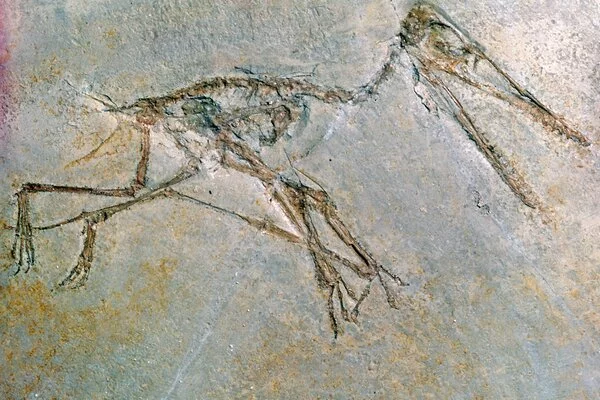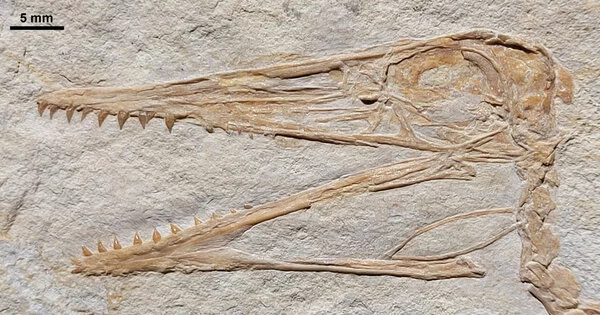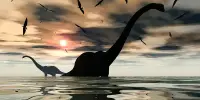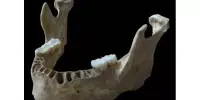The oldest Pterodactylus fossil found in Germany is from the Late Jurassic period, about 150 million years ago. Pterodactylus is an extinct genus of pterosaur, a type of flying reptile. The fossils of Pterodactylus were first described by German naturalist Ernst Stromer in 1915, who found several well-preserved specimens in the Solnhofen limestone of southern Germany. These fossils provided important insights into the anatomy and behavior of pterosaurs.
The oldest specimen of Pterodactylus was discovered near Painten, Germany. The Pterodactylus fossil is approximately one million years older than other Pterodactylus specimens. The specimen is a complete and well-preserved skeleton of a small person. It is a rare ‘sub-adult’ individual, with a 5-cm-long skull.
Pterosaurs, or flying reptiles of the dinosaur era, first appeared in the Late Triassic period (227 million years ago) and went extinct during the Cretaceous extinction event (66 million years ago). They dominated the world’s skies for more than 160 million years, with wing spans ranging from 1 to 12 meters.
The first described and named pterosaur and namesake of the whole group — is Pterodactylus from the famous Solnhofen Limestone of Bavaria, southern Germany. Originally described in 1784 by the Italian naturalist Cosimo Alessandro Collini, the fossil was considered to be an aquatic animal for 25 years, before Georges Cuvier found out it was a flying reptile belonging to a new, previously unrecognized group.
The rocks of the quarry that yielded the new Pterodactylus specimen are silicified limestone that has been dated to the upper Kimmeridgian stage (around 152 million years ago). Previously, Pterodactylus had only been discovered in younger rocks of southern Germany from the Tithonian stage, which follows the Kimmeridgian.
Felix Augustin
The oldest specimen of this iconic pterosaur was recently discovered near Painten, a small town in the southern part of the Franconian Alb in central Bavaria. The fossil, described in the journal Fossil Record, is approximately one million years older than other Pterodactylus specimens.
The specimen was discovered in 2014 during excavations in an active limestone quarry. It took more than 120 hours of meticulous mechanical work with pneumatic tools and needles before the researchers could study it. The discovery was made by Felix Augustin, Andreas Matzke, Panagiotis Kampouridis, and Josephina Hartung of the University of Tübingen (Germany), and Raimund Albersdörfer of the Dinosaurier Museum Altmühltal (Germany).

“The rocks of the quarry that yielded the new Pterodactylus specimen are silicified limestone that has been dated to the upper Kimmeridgian stage (around 152 million years ago),” explains Felix Augustin of the University of Tübingen, the study’s lead author. “Previously, Pterodactylus had only been discovered in younger rocks of southern Germany from the Tithonian stage, which follows the Kimmeridgian.”
The specimen is a complete, well-preserved skeleton of a small-sized individual. “Only a small portion of the left mandible, as well as the left and right tibia, is missing. Otherwise, the skeleton is nearly perfectly preserved, with every bone present and roughly in its correct anatomical position “The researchers write in their study.
The Painten Pterodactylus, with a 5-cm-long skull, is a rare “sub-adult” individual. “In general, Pterodactylus specimens are not evenly distributed across the entire size range, but rather fall into distinct size-classes separated by distinct gaps. Painten’s specimen is a rare example of the first gap between small and large sizes “Augustin explains. “At the time of its death, the Painten Pterodactylus was of an intermediate, and rarely found, ontogenetic age, between two consecutive year-classes.”
Many other “exquisitely preserved fossils” have been discovered at the Painten quarry, including ichthyosaurs, turtles, marine and terrestrial crocodile relatives, and dinosaurs. Many of them, including this new pterosaur specimen, are on display at Denkendorf’s new Dinosaurier Museum Altmühltal (Bavaria, Germany).















